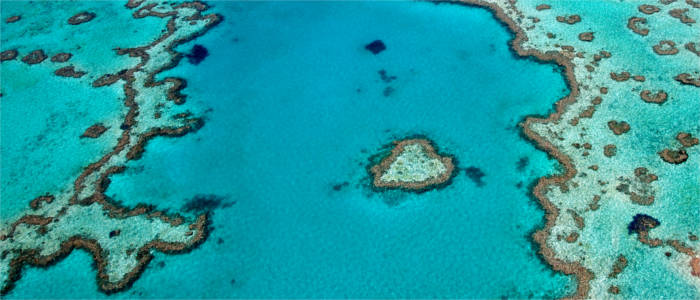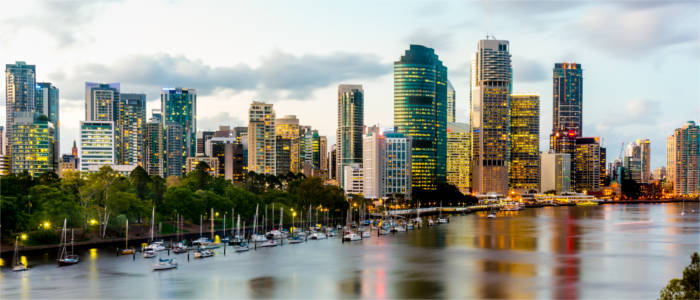Travel Offers
Travelmyne Featureprint
Distance
Queensland - The Diverse Sunshine State
Queensland is one of the most beautiful and diverse states in Australia. It offers wonderful white sandy beaches, tropical rainforests, the Australian outback, a deserted desert landscape and unique World Natural Heritage sites like the Great Barrier Reef.

Geography - Australia's second largest state
Queensland (capital: Brisbane) is a state in the north-east of Australia. With an area of 1,730,650 km², it is the country's second largest state after Western Australia. It borders on New South Wales and South Australia in the south and on the Northern Territory in the east. In addition, the Sunshine State's shore meets the Coral Sea and the Gulf of Carpentaria. The state's shoreline is about 7,000 kilometres long. Queensland's northernmost point, Cape York on the Cape York Peninsula, is also the northernmost point on the Australian mainland and is about 140 kilometres away from Papua New Guinea. The region's highest mountain is Mount Bartle Frere with a height of 1,622 metres. There are three climate zones in Queensland. It is subtropical and warm in the south, tropical in the north and rather continental in the west. Two seasons dominate the life of the state's 4.7 million inhabitants: the hot, rainy summer (November to March) and the warm, dry winter (April to October).

Nature - Rainforests, coral reefs and the Australian outback
Due to the climatic conditions, the nature in the east differs considerably from the western part of the state. In the west of Queensland, you find the typical Australian outback with dry deserts (Sturt Stony Desert, Strzelecki Desert, Simpson Desert), while the east and the coastal areas are characterised by white sandy beaches, wonderful coral gardens, dreamy islands and tropical rainforests. The latter vegetate the Kuranda and the Daintree Rainforest, the oldest rainforest on earth, in the north-east as well as the Lamington and Springbrook National Park in the region's south-east. These impressive nature reserves are part of the UNESCO World Natural Heritage. Travellers see long, white dream beaches on Fraser Island, the world's greatest sand island, and on the Whitsunday Islands at the Great Barrier Reef, which is the greatest coral reef on earth. The water around the reef is crystal clear, so that you can see down to 60 metres. Furthermore, it is characterised by an extraordinarily diverse underwater world. It is said that this greatest living organism on earth, which has over 1,500 tropical fish species, flat reefs, lagoons, numerous bays and long sandy beaches, can even be seen from space. The coral reef is often called the "eighth wonder of the world" or the "world's largest aquarium" and - like Fraser Island - it is a World Natural Heritage site of the UNESCO.

Culture - Following the traces of the aborigines
Australia's native inhabitants can be traced back 50,000 years in Queensland. 26% of Queensland's population are aborigines, which is the second highest proportion in the whole of Australia. The unique way of living and culture of the Australian aboriginal people can be experienced at first hand in the region's rainforests in the north and south. Several tribes offer tours (often lasting several days) which show tourists the way of living and customs of the aborigines. In addition, visitors can explore their traditions and art in the Tjapukai Aboriginal Cultural Park near Cairns or the Queensland Gallery of Modern Art in the capital. The latter is the second largest museum in Australia and does not only accommodate the work of Australia's native inhabitants but also art projects by Asian, Pacific and international artists. The lively metropolis of Brisbane is definitely worth a visit. It is the sunniest big city on the continent, is called "Brissie" by the locals and constitutes Queensland's political, economic and cultural centre. Other worthwhile destinations are the port cities of Cairns and Townsville.

Experience - The vibrant life in the big cities
Most activities in Queensland take place in the coastal regions (Sunshine Coast, Gold Coast) and in vibrant metropolises such as Brisbane, Cairns and Gold Coast. Party-goers from all over the world enjoy experiencing the exciting nightlife in these big cities and exploring their many pubs. There is an abundance of shopping facilities and a great variety of restaurants, cafes and bars. They offer international dishes as well as freshly caught fish and local wine.

Activities - Experiencing the water sports oasis and the Australian fauna
Queensland is an eldorado for water sports fans. That is no wonder considering the endless sandy beaches and the worldwide unique Great Barrier Reef. Surfers, sailors, kayakers, canoeists and divers can pursue their hobbies at the Gold Coast throughout the year. Many operators offer diving courses, which last for several days or take place at night, during which holidaymakers can marvel at the diversity of the world-famous coral reef. In the Reef HQ, the greatest coral reef aquarium in the world, travellers can experience the breathtaking fauna of the Great Barrier Reef while staying dry. Other attractions are the Billabong Sanctuary in Townsville, in which you can watch koala bears and kangaroos at close range, and the Mon Repos National Park in Bundaberg. Visiting the latter, you can see baby turtles hatching and taking their first steps towards the sea. In addition, you can go golfing, climbing, cycling and horseback riding in Queensland.

Information
Queensland can be travelled at any time of the year because even the Australian winter (November to March) is pleasantly warm. During the rainy season (November to April), however, there may be heavy rainfalls, which can cause flooding. Holidaymakers should also beware of box jellyfish, which populate the tropical waters at this time. Nets are spanned and warning signs are put up at many beaches to protect visitors form the venomous animals. Travellers should bring sunscreen and mosquito repellent. While bathing at the beaches, you should look out for the red and yellow flags. They indicate the safest swimming areas.
Queensland is the perfect destination for water sports fans. The crystal clear water around the Great Barrier Reef is not only favoured by numerous fishes but also by divers from all over the world. Culture enthusiasts, on the other hand, travel the state to learn about the culture of the aborigines and visit metropolises like Brisbane.










